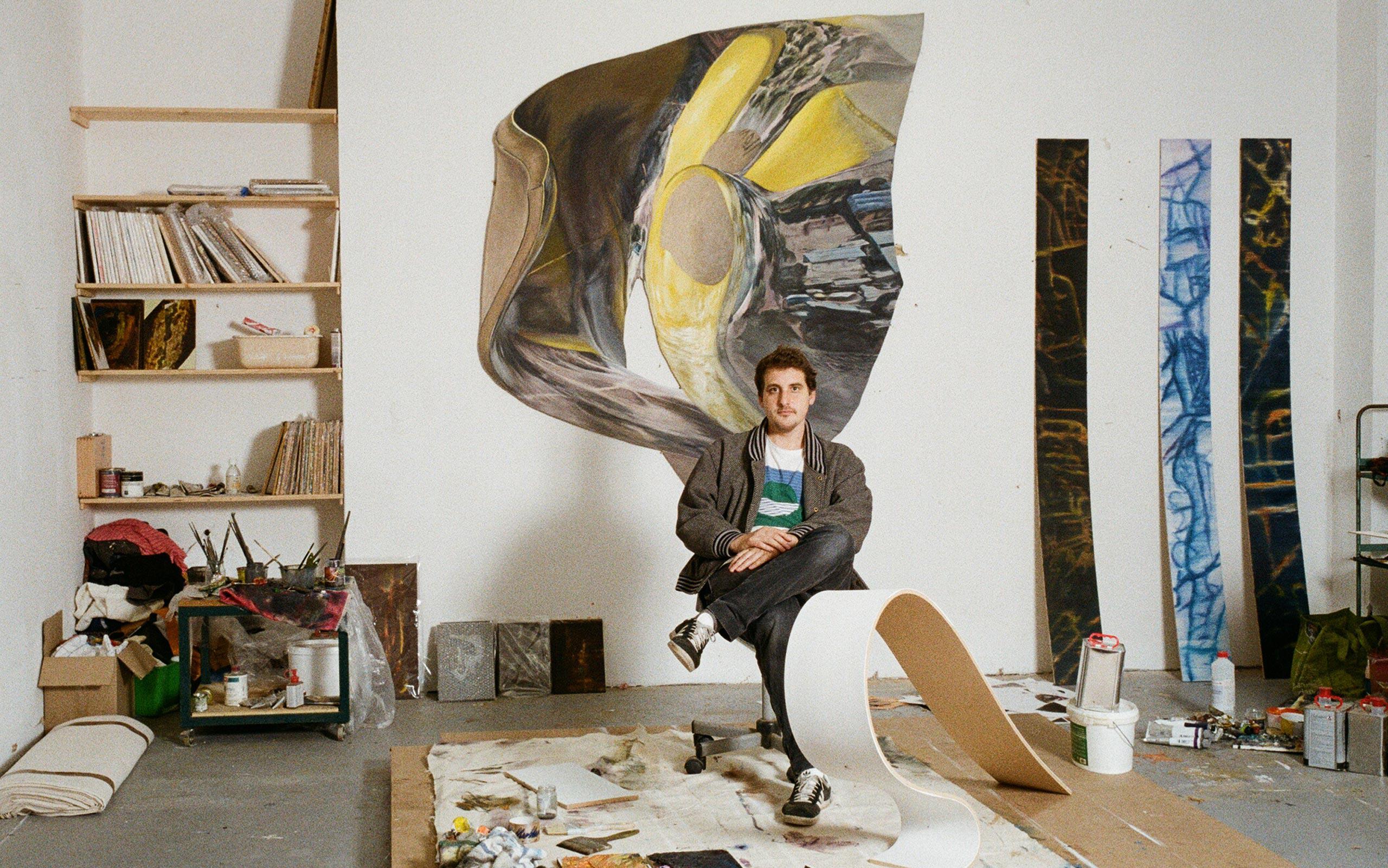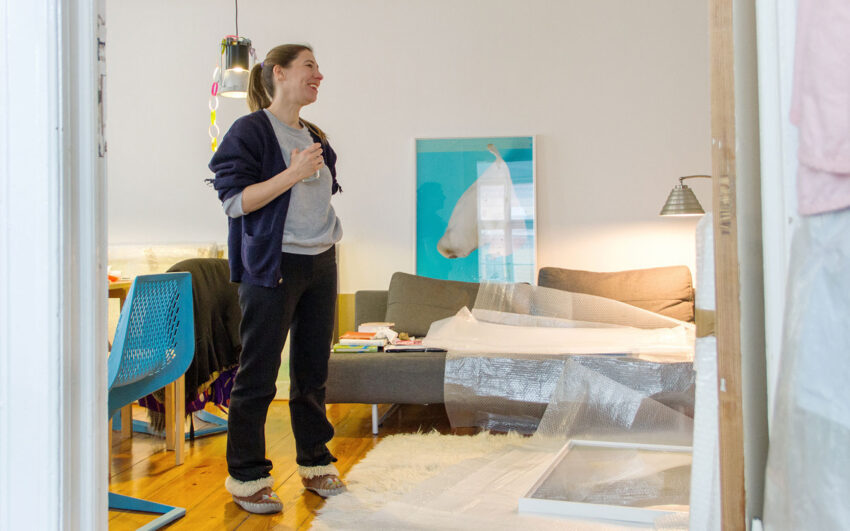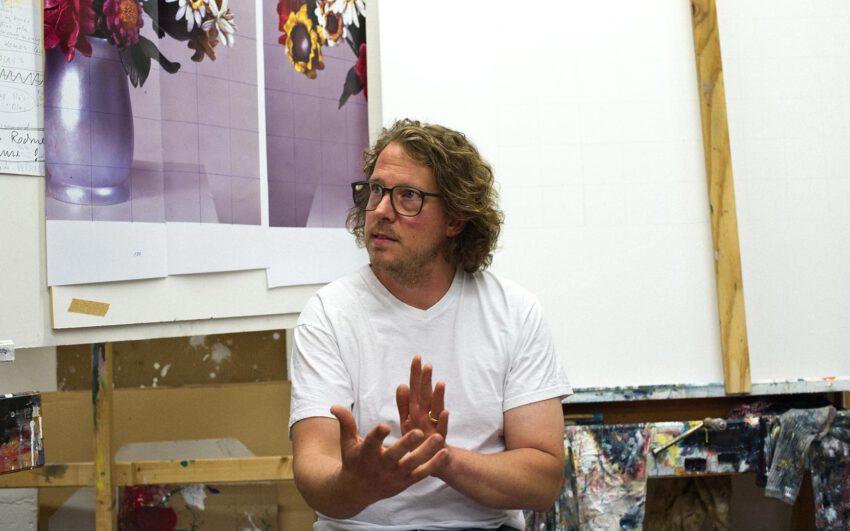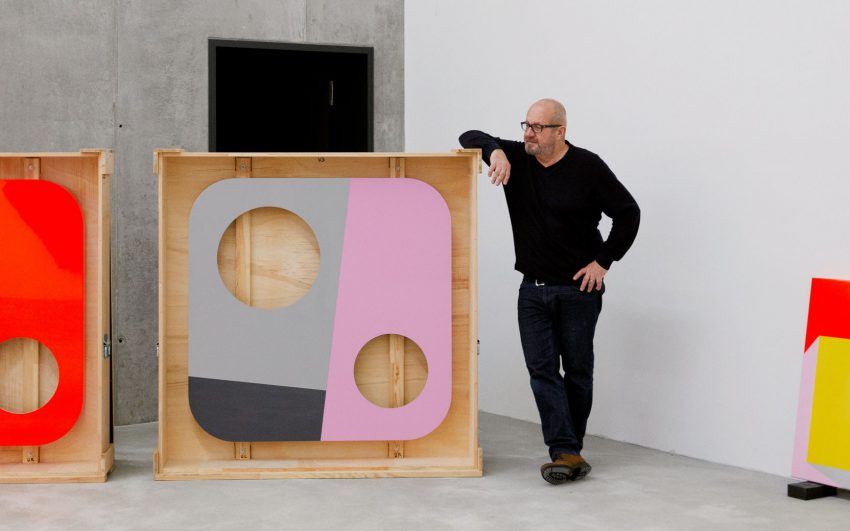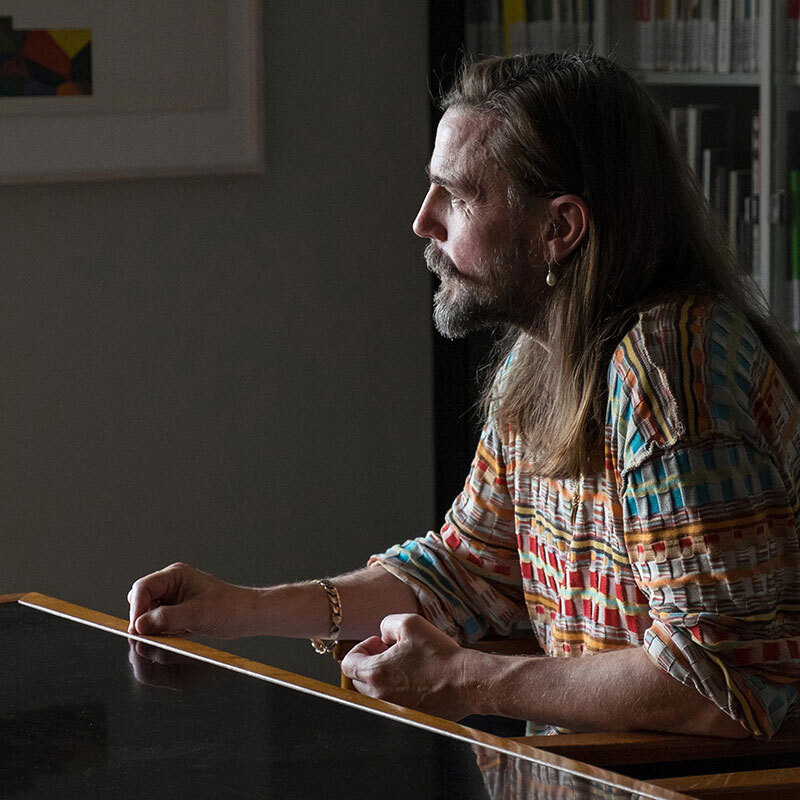The fine artist Stefan Reiterer uses painting and computer animation to explore the malleability of the world. His work thus moves at the interface between virtuality and reality to go beyond the conventional, two-dimensional image, creating entities that oscillate between abstractions and blurred landscapes.
Stefan, what was your path to art?
This has to do with the artist Franz Part, my art professor at grammar school. He turned the school in my hometown in the Waldviertel into a kind of total work of art by involving all the students and turning the entire building into a kind of universal museum with replicas of famous works by Joseph Beuys, Méret Oppenheim, and Marcel Duchamp. If you went to school there, you were constantly surrounded by modern art history and that influences you on a subconscious level (laughs). He had a big influence on me in that he saw my interest in drawing and painting and started giving me input. I would often go home with kilos of catalogues from his library in my backpack... That was quite cool and undoubtedly the introduction to art for me.
You then studied painting at the Academy of Fine Arts in Vienna. Why painting?
Perhaps it is most interesting if you have already had some kind work experience, have studied beforehand or so and can take that experience with you into your work at the academy. Or if you already have a rather advanced practice and know where you want to go with it. But it seems many people come to the academy and only then begin to get an idea of the entire spectrum of media and methods of art possible through various courses and seminars. However, in my case, the entrance exam was right after school, and I did have a portfolio of graphics and paintings.
Did your family and friends support you in your career choice to become an artist or was there a plan B?
No, there was no Plan B. But there was always support, even though my parents didn’t have anything to do with art or the art world per se. I think they, like me, understood only gradually what such a study and such a career choice involved.
And when did you realize, I am an artist now?
I think during the time at the academy when I had already had several exhibitions. I realized that it can really become a profession when the administrative work increases, when all you do is sit at the computer, write and respond to emails, and attend to your tax returns; it is at that point you realize you have become an artist...
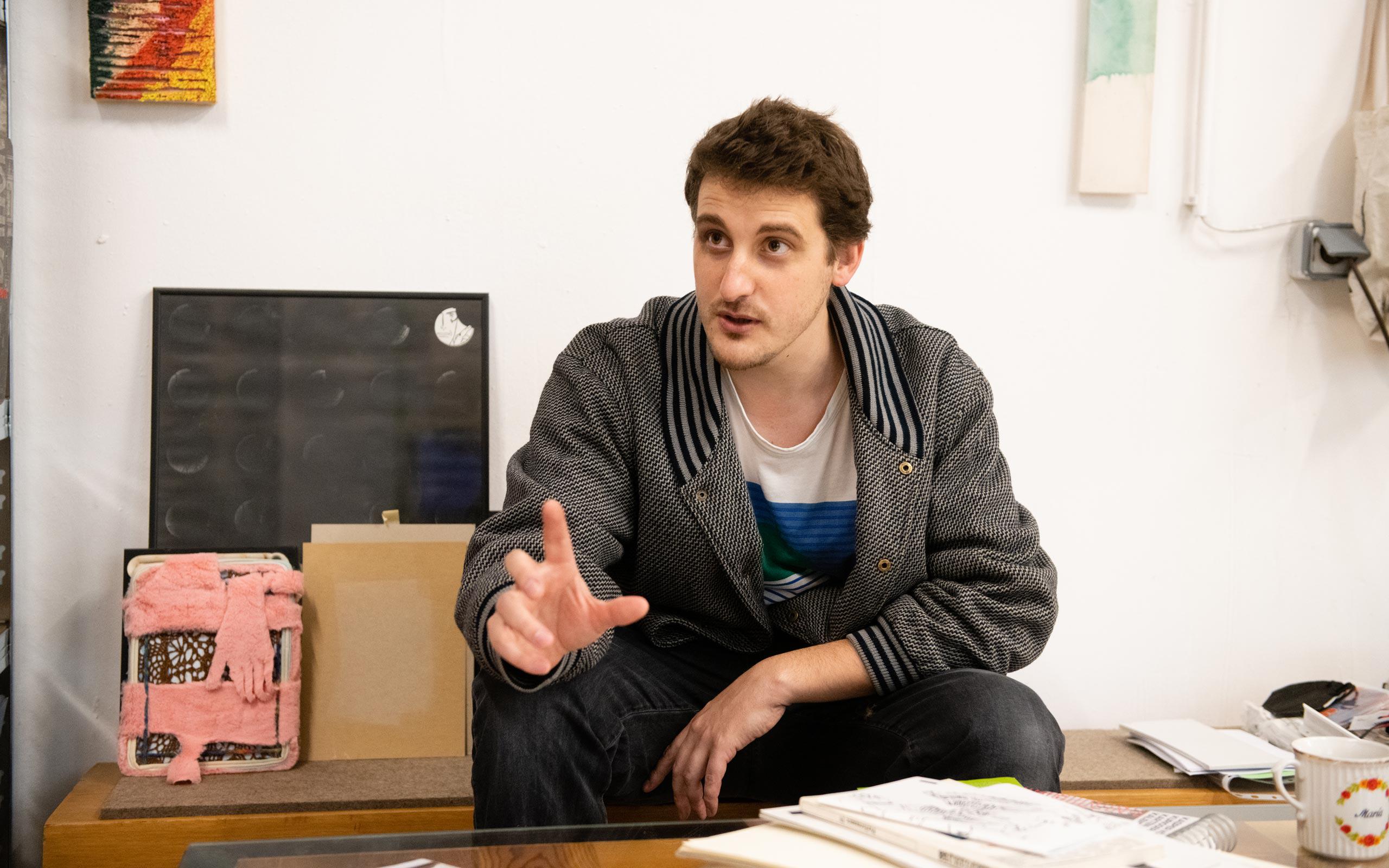
As an artist, do you like to be responsible for everything yourself or do you feel the need for assistance?
I like being on my own, but of course it would be great if you could hand things over. When you study, you don’t necessarily acquire the administrative skills I spoke of. I have done a lot of jobs in galleries and museums and learned much from more experienced artist colleagues. There are certain seminars for alumni, for the design of portfolios, etc., but after that it’s up to associations like the Interessensgemeinschaft Bildende Kunst to explain how social security works or what “fair pay” means. Maybe that has improved in the meantime, but I found it a bit lacking that these skills are often left out, even though they really are intrinsically concerned with the reality of your daily life as artists.
In addition to your own artwork, you run the artist-run-space “new jörg” in Vienna together with Axel Koschier. Can you tell us more about it?
The Kunstverein has been around since 2013, founded by Axel Koschier, Bernhard Rasinger, and Saskia Te Nicklin. When I moved into the newly established shared studio, I started to organize my own exhibitions in the “new jörg” space. Bernhard and Saskia left the association in 2015 due to time constraints and since then Axel and I maintain it. But everyone who has rented space in the attached studio Pappenheimgasse 37 can organize exhibitions, concerts, screenings, etc., because they pay for the space. This ensures that the program remains very lively.
Actually, the association also gives artists a greater visibility.
Exactly. From the beginning, the idea was to provide a space and a platform to artists who have less visibility or no gallery presence in Vienna. So far, through funding from the state, city, and district, we have had the opportunity to organize over sixty solo exhibitions and projects in Austria and abroad, and to publish nearly thirty publications. In doing so, we have always made sure to pay all participants an artist’s fee.
Do you see any advantages here compared to gallery representations?
We are much more flexible and are not dependent on sales. Therefore, invited artists can realize the most uncompromising ideas. Of course, this arrangement doesn’t preclude sales, which do occur from time to time. We also have an online store on our website were certain editions and publications we publish can be purchased. At the fairs to which we are invited to attend as “new jörg” we are perceived differently as an artist-run project space. Fundamentally, it is an exhibition space and a presentation opportunity for very good, though perhaps not yet well-known artists. Often, this international visibility and subsequent attention can be all important, yet it is necessary that it is not restricted by sales pressure.
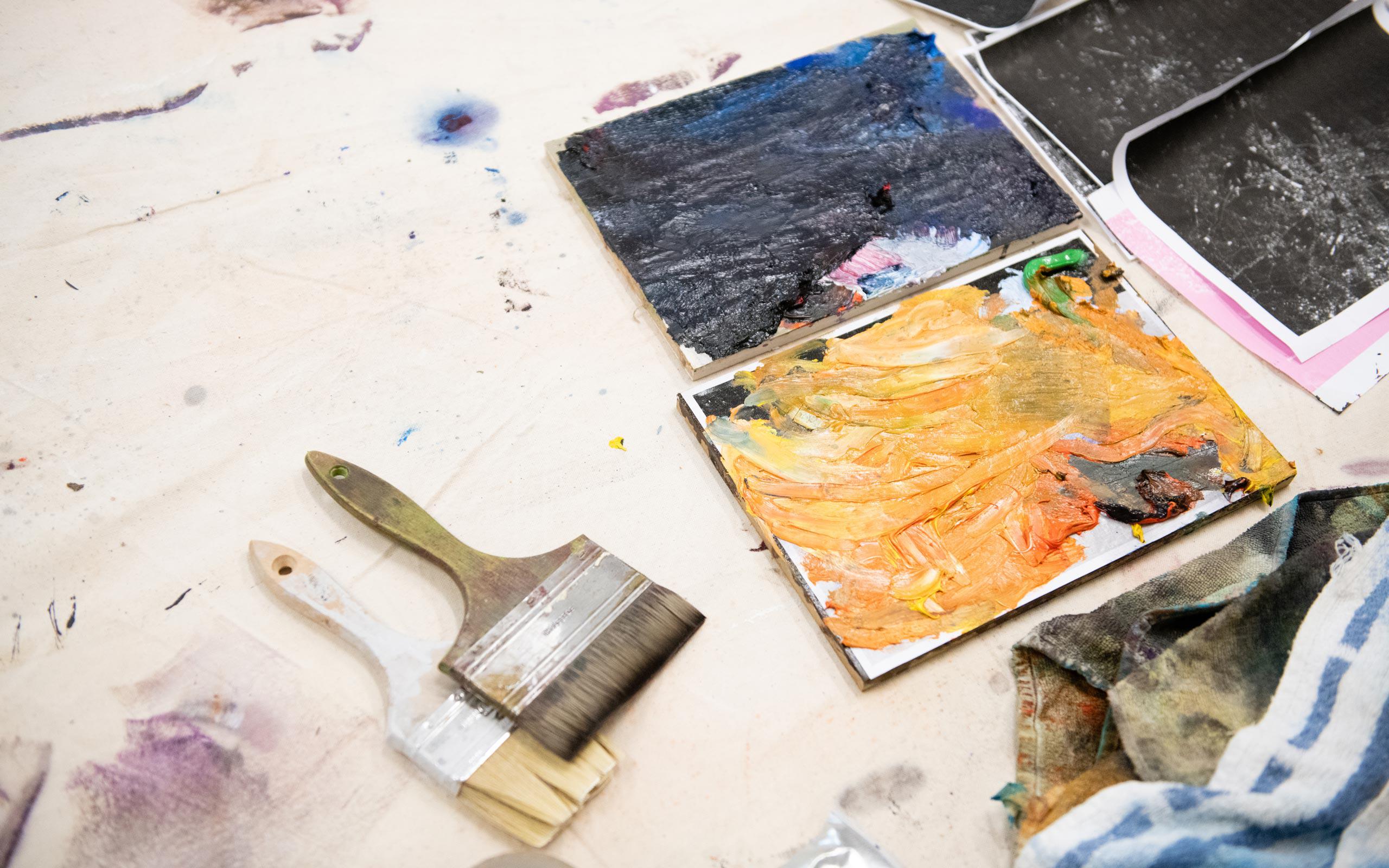
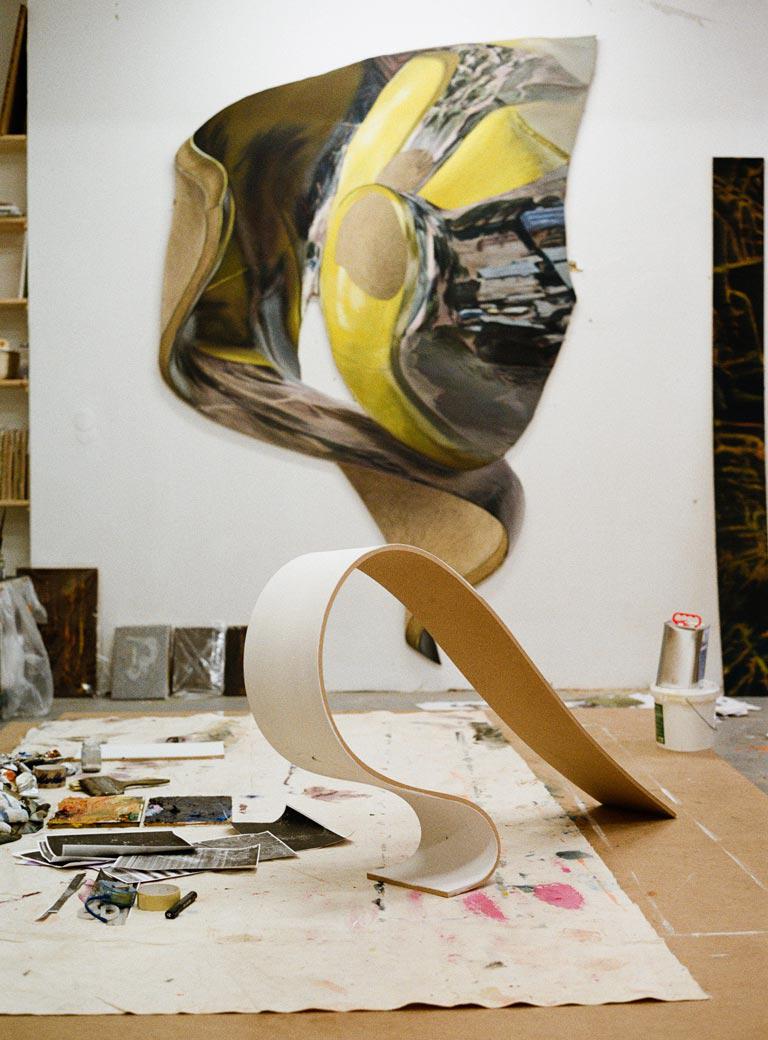
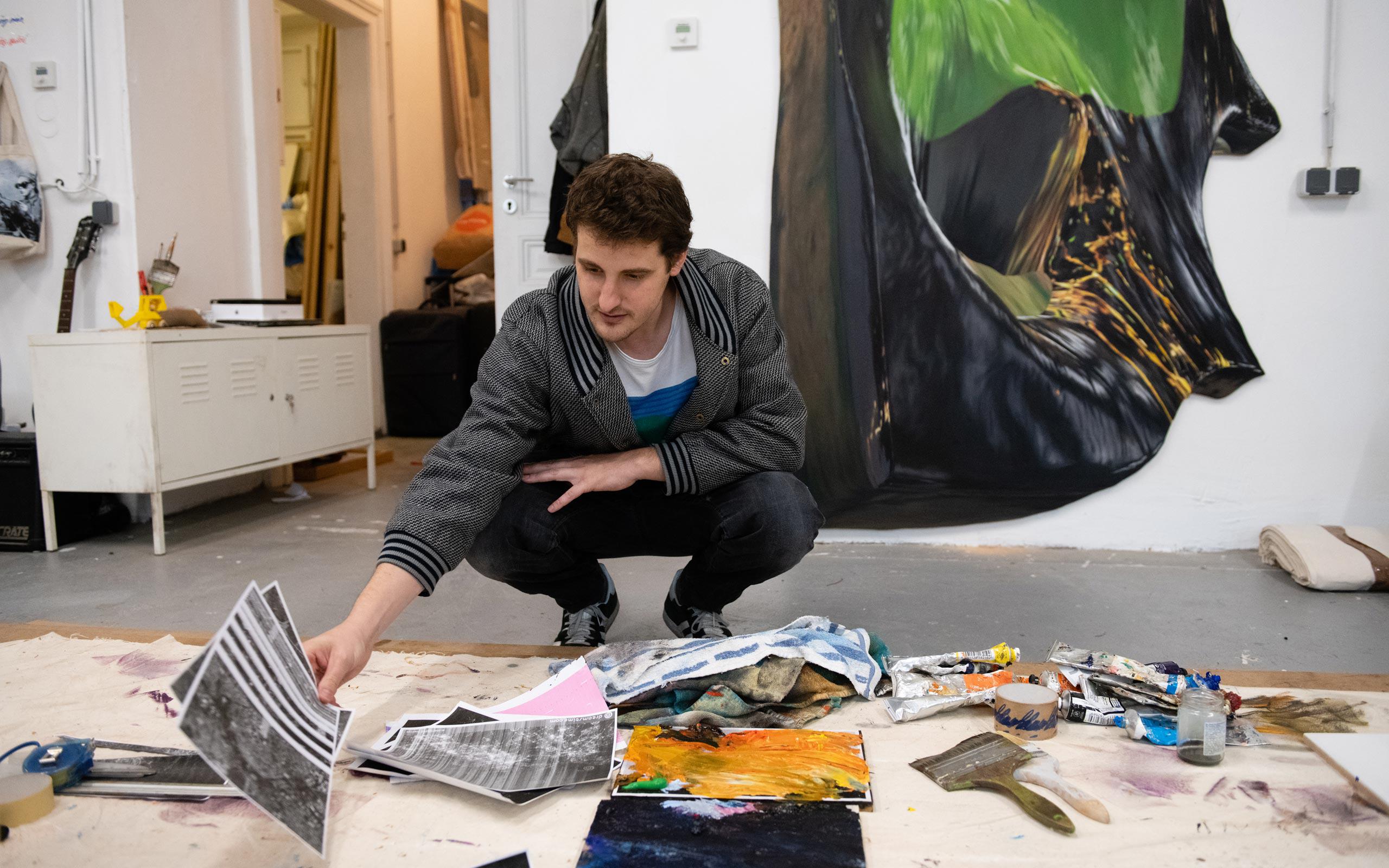
Your work is defined through painting and creation in both analog and digital space, what are the themes that occupy you?
Basically, they concern a quite central question: That is, how objective an image of the world can actually be and to what extent it is constructed. Since I also work with digital satellite images, such as those provided by Google Earth and Google Maps, the question always arises to what extent these images provided by large technology corporations or governmental, military organizations, are “true” or not. But the digital approach is also involved in other ways, for example in my collaboration with the Canadian artist Jeremy Bailey for the exhibition Deflection (2022) at Galerie CRONE in Berlin, when avatars of deceased artists from the gallery, which he had designed, met my work in the exhibition.
In your abstract painterly works, there are certainly elements in which reality appears to be involved and one could easily identify what might be a representation of the sky, the wall of a house, a street…
It’s an interplay that mixes abstraction and figuration, clarity and ambiguity. Perhaps the beginnings of this lie with the course work for which I earned my diploma from the academy, which was on the interplay of pixel and vector graphics and their use in relation to painting. I’m intrigued when amorphous, microscopic, or macroscopic structures migrate into the representational. When blurry, luminous vessels suddenly become nocturnal streetscapes, viewed from an airplane. I think it’s nice when there’s a lot of room for interpretation. In my eyes, there’s nothing more boring than art that can be quickly grasped, that has been reduced to a single reading.
Are there responses that you’d like to see?
No. I am satisfied with everything, even if there is harsh criticism. It has happened that people have believed that they recognize elements in the works as being based on satellite images, which is unlikely, absurd, and irrelevant in terms of viewing the works. I do enjoy a direct exchange with people about my work or for that matter the work of others, since it often creates a feedback loop that attains a deeper level of comprehension.
How would you describe your work in a few words?
It is a preoccupation with space and how you can represent it by painting or change it by simple means, whether that be achieved with analog or digitally, or in the form of an architectural conception. Currently, my work is purely in the context of painting.
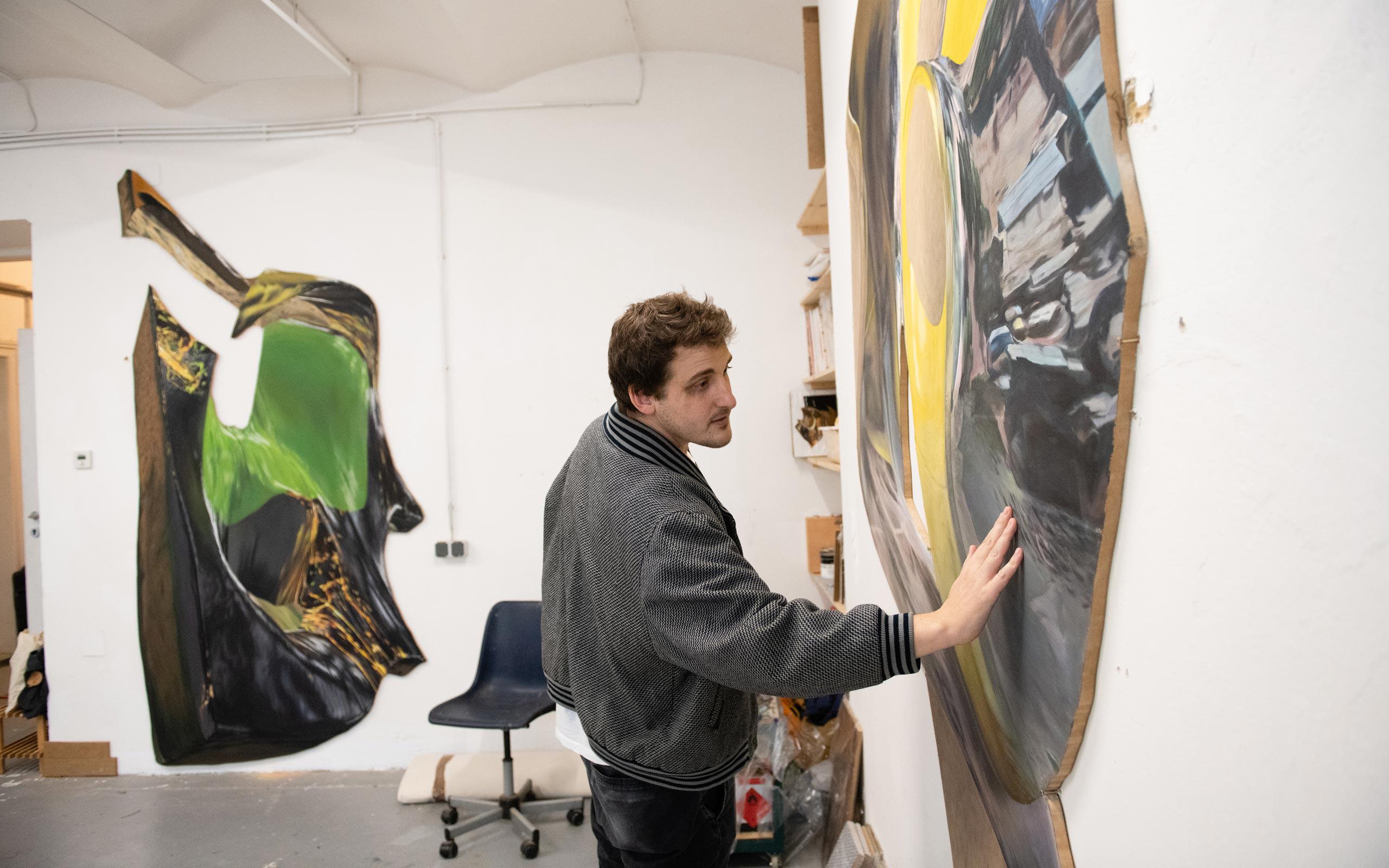
You once said, “Painting – it is not just a picture flat on the wall.” Can you elaborate?
This could be answered art-historically, from Bauhaus, to Sam Gilliam, to Katharina Grosse. Since 2011, I have been working with installations, with stretched, painted fabric panels, or shaped MDF panels that define exhibition spaces, their architecture, and visual axes. The works I am doing now are also either object-like or give an illusionistic spatiality and do not operate in a classical format.
How exactly do you take up space?
It depends. For a solo exhibition, it’s a process with lots of sketches and models that clarify ideas. For a group show, I try to be defensive, that is, to see what is possible... For example, when it concerns an installation, I usually work on the final form only during the construction, in exchange with the other participants. Since the work usually affects the other positions and views in the space, it's a challenge. But that also makes it exciting, it's delightful.
To stay on the subject of space: Do you have to be personally on site or are plans of the space enough for you to work with?
I prefer to be on site. In the last two years, or during the pandemic, I have also been able to organize exhibitions over long distances; for example, in an exhibition with Bente Skjøttgaard at “Stereo Exchange” in Copenhagen. Or in a beach cave in Sydney, but in such cases I give more or less clear instructions and say: this way or that way the fabric can be attached and cut. In the case of another exhibition in Sydney, my artist friend Alexander Jackson Wyatt said during installation, “Ah, so I can do whatever I want with your work!” And I replied, “Actually, yes, you can.” That kind of ease has a lot to do with my experience with collaborations, where something is developed together. I got rid of that reverence for my own work at some point. If something unpredictable happens with it, something I can't stop, then I accept it as part of the process.
It almost sounds as if your art is allowed to have a life of its own …
Yes, I think so. Nothing will last forever. Most of my paintings are created on MDF; they’re fixed with an acrylic binder, but they’re not going to last 500 years. I think because I and many of my colleagues don’t necessarily incorporate these conditions of durability and sustainability into our art production, it will probably be a golden age for conservators (laughs).
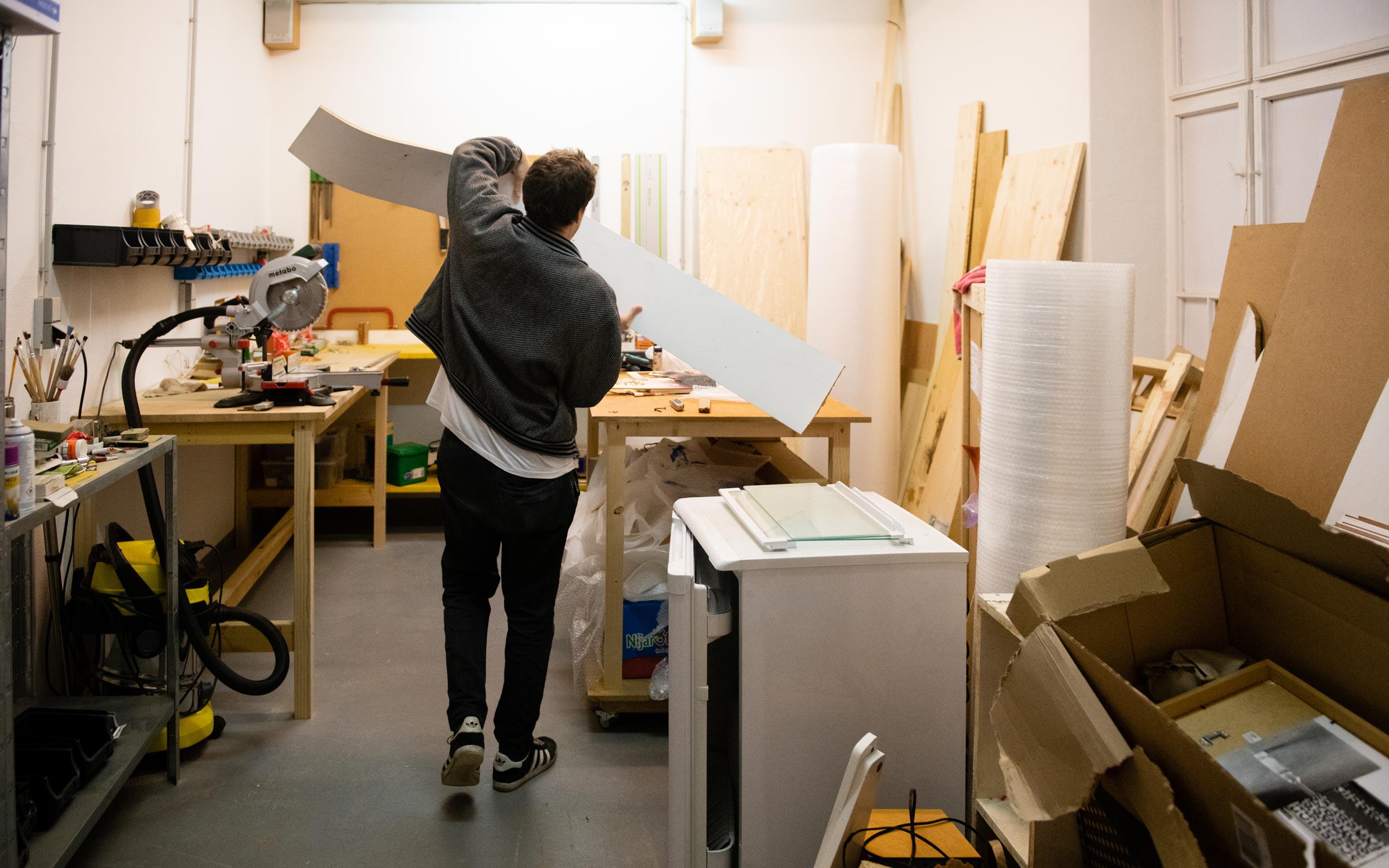
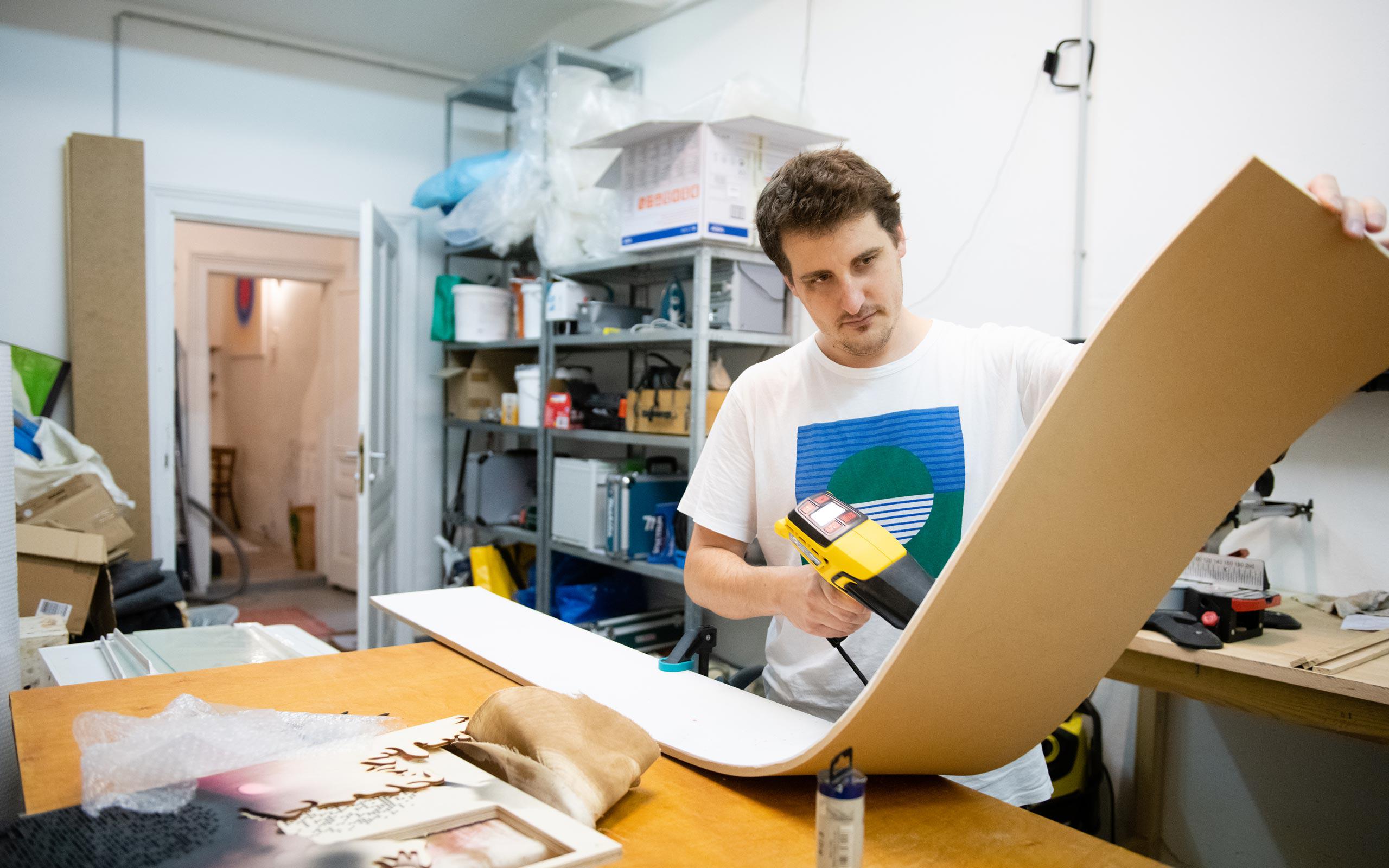
So, does your art only fit into today’s times?
This raises more of a counter question for me: how will people see the work in 50 years? That is what concerns me more. Whether it fits into today or not is not the question, because I’m doing it now. I would like to think it has a certain timelessness.
Does that imply that there are moments of doubt in the work process?
Yes, every day. I think that’s part of the process and is what keeps you going. If I were to say that every design and every piece of work is insanely good, then that would be more of a very enjoyable hobby than a serious discussion. It is better to arrive at a point that really intrigues you through difficulties. This also has to do with the fact that you usually look critically at others and at their art, and that this gives you something back for your own thinking, for your own work.
They say you deliberately avoid meaningful titles.
In some cases, they are loaded with meaning. For example, there is the series DATA SIO, NOAA, U.S. Navy, NGA, GEBCO, which lists U.S. organizations whose satellite imagery is tied to copyright. It’s a joke, gives direction, and is political. But I can handle it better if my work is not named.
Do you always work in series?
Actually, yes. There are some larger series that influence each other. For example, the fabric installations are called texture mapping, smaller form studies, paintings, and collages are called images, painted 3D prints are called formants and large images cut into shape are called templates.
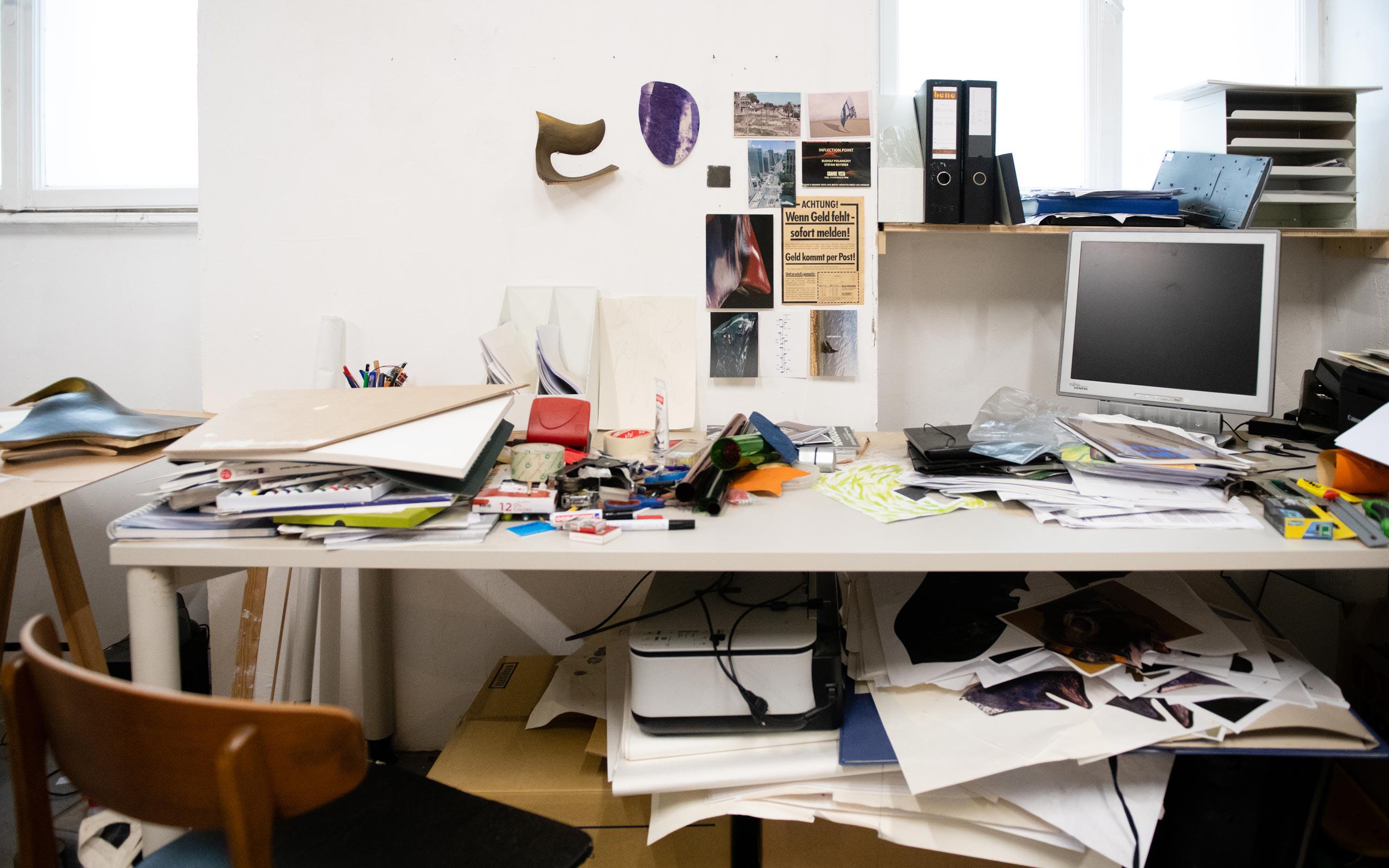
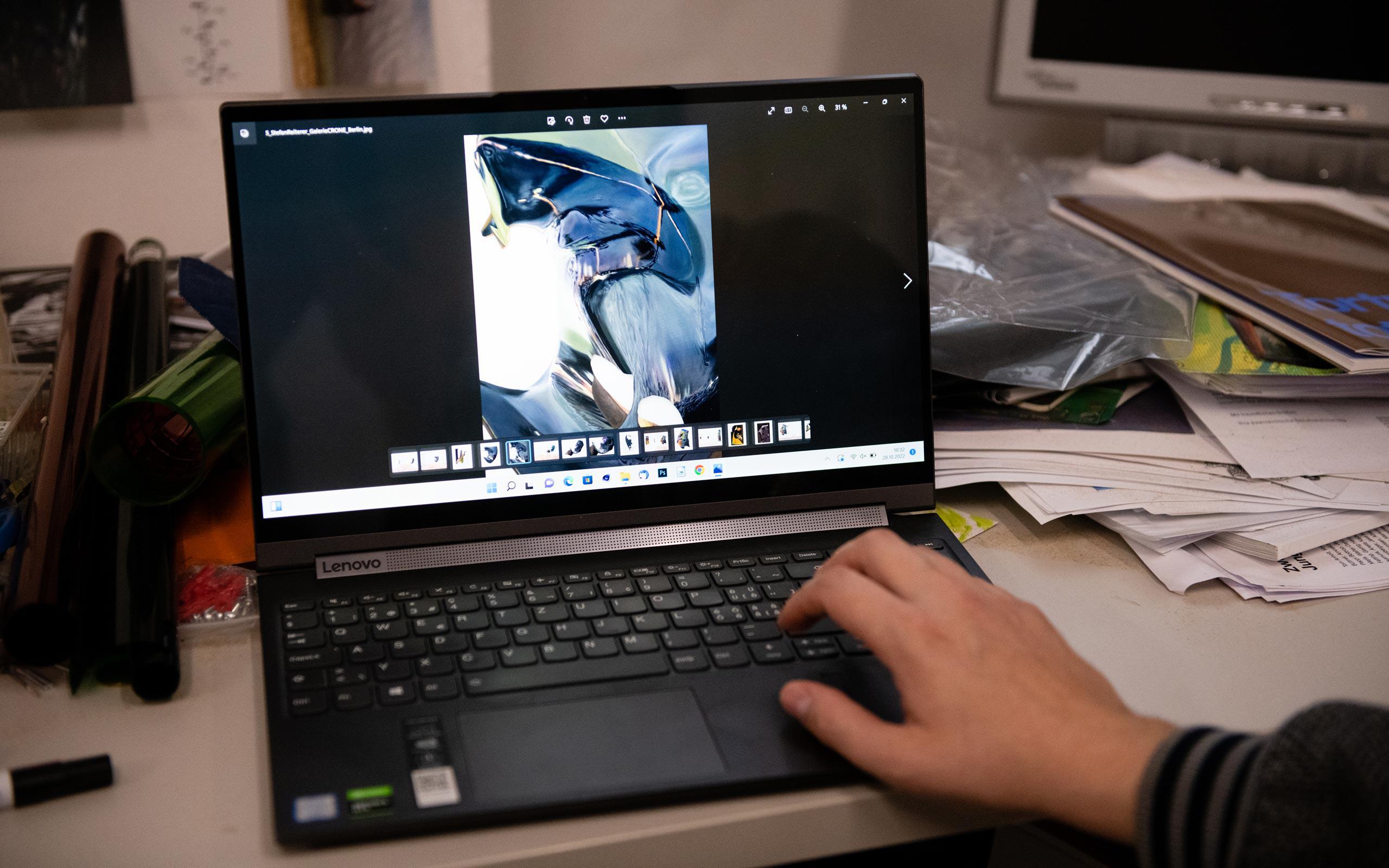
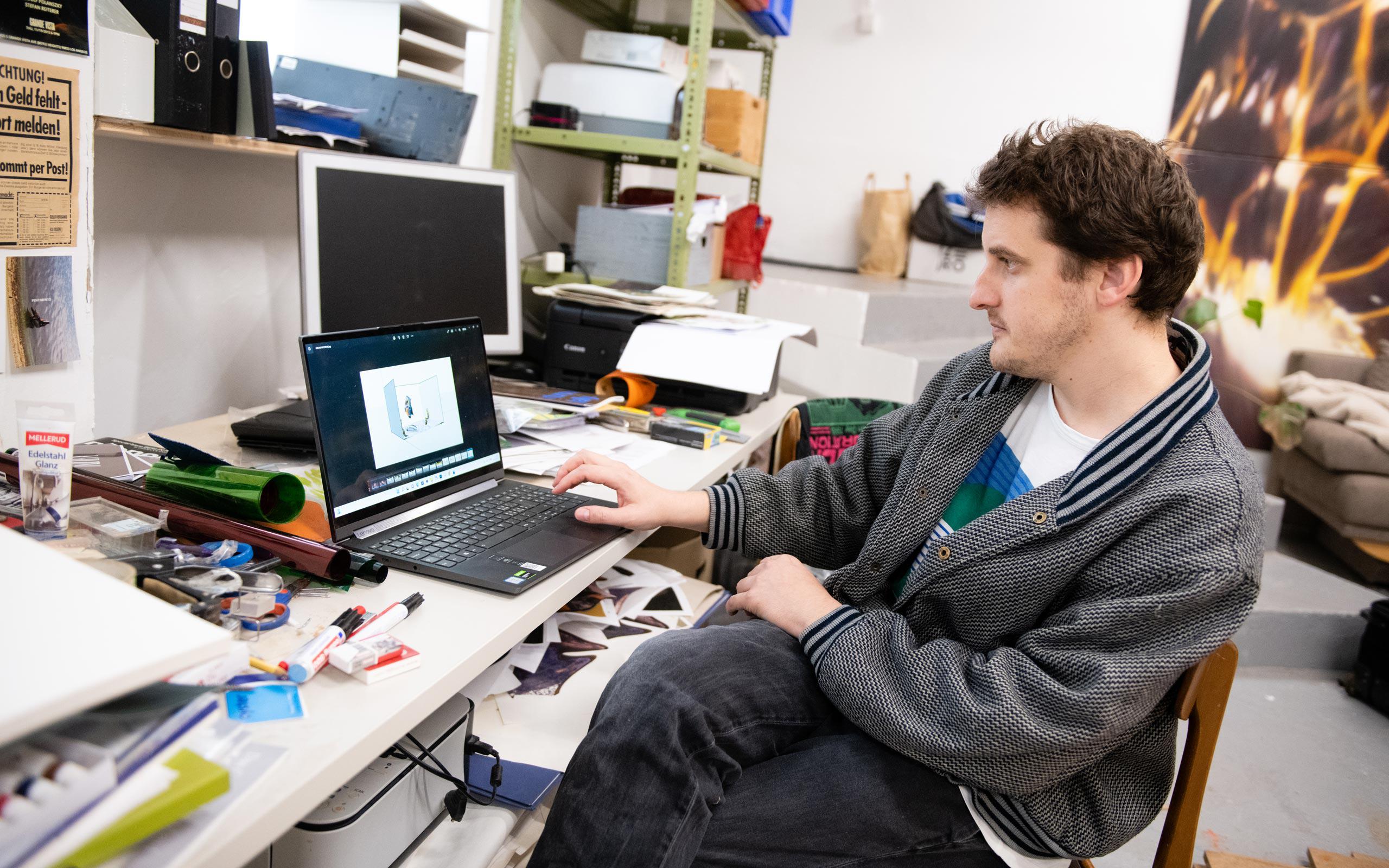
Apart from the bureaucratic hurdles in everyday life, what does your typical creative process look like? Do you come up with a concept or do you work more intuitively?
It varies, but there’s usually a reason to do something and then for most of it, like the larger solo shows, the computer work is very relevant – that involves sketching and modeling; for that I use software programs and a kind of well-rehearsed way of working. In addition, I’ve been fortunate to have been on artist-in-residence residencies before the last few major exhibitions. That’s quite good because you can isolate yourself a bit. But it’s often the work on the screen where a lot of decision-making takes place, and only then does it go into the production process to paint the images. Sometimes it's the opposite, and the painted or collaged images reappear as photos in the 3D models and renderings.
What drives you in your artistic work?
The most significant point is art itself, looking at exhibitions in museums, galleries, and other spaces. And then many other things are involved, such as travel, books, etc. Also, the exchange with other artists, it’s very organic and things flow in a subconscious way. Above all, it’s important that I no longer have to begin from point zero, I can develop things further from the point I have already attained.
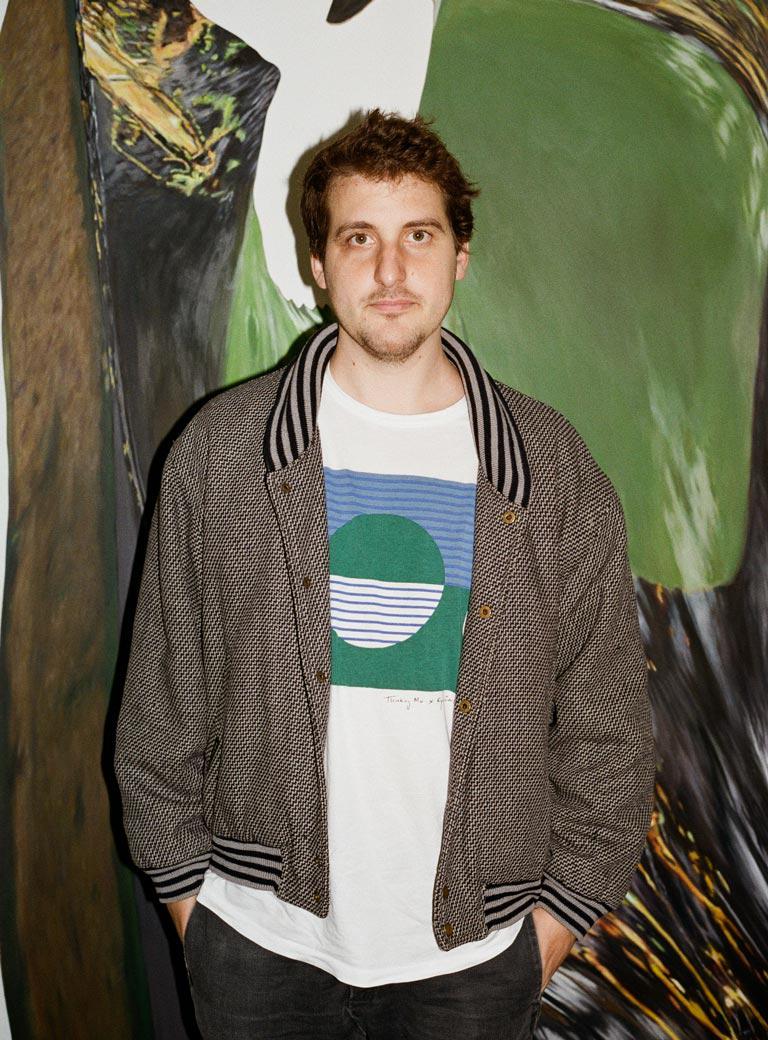
Vienna is now the city in which you live and work. What distinguishes this city as a place to make art?
First, Vienna is still affordable compared to other cities. I can’t imagine having a studio like the one I’m renting here in Paris or London without having three part-time jobs and no time left for my own work. Compared to other countries in Europe, public support is extremely good, there are grants and prizes. This means that art and culture in general are given a high priority. Even if these subsidies, especially when it comes to the independent scene away from the big houses and institutions, are often put under pressure by right-wing politics. One of the most interesting developments in recent years has certainly been the establishment of the Independent Space Index, an association of Vienna’s “off-spaces” and the resulting exchange among them. The artist Francis Ruyter once summed it up very well: If one were to add up all the artist-run spaces, cultural associations, project spaces, etc., their exhibition space and the insanely diverse programs, it would result in the largest, most densely programmed exhibition house, endowed with the smallest budget of all.
What are you currently working on?
It’s been very busy lately and I’m looking forward to the coming year as I will be in Paris for some time with my partner, who is a performance artist, and our son, because she received a scholarship there. It’s a very good time to clear my head, get things in order and become involved in new things.
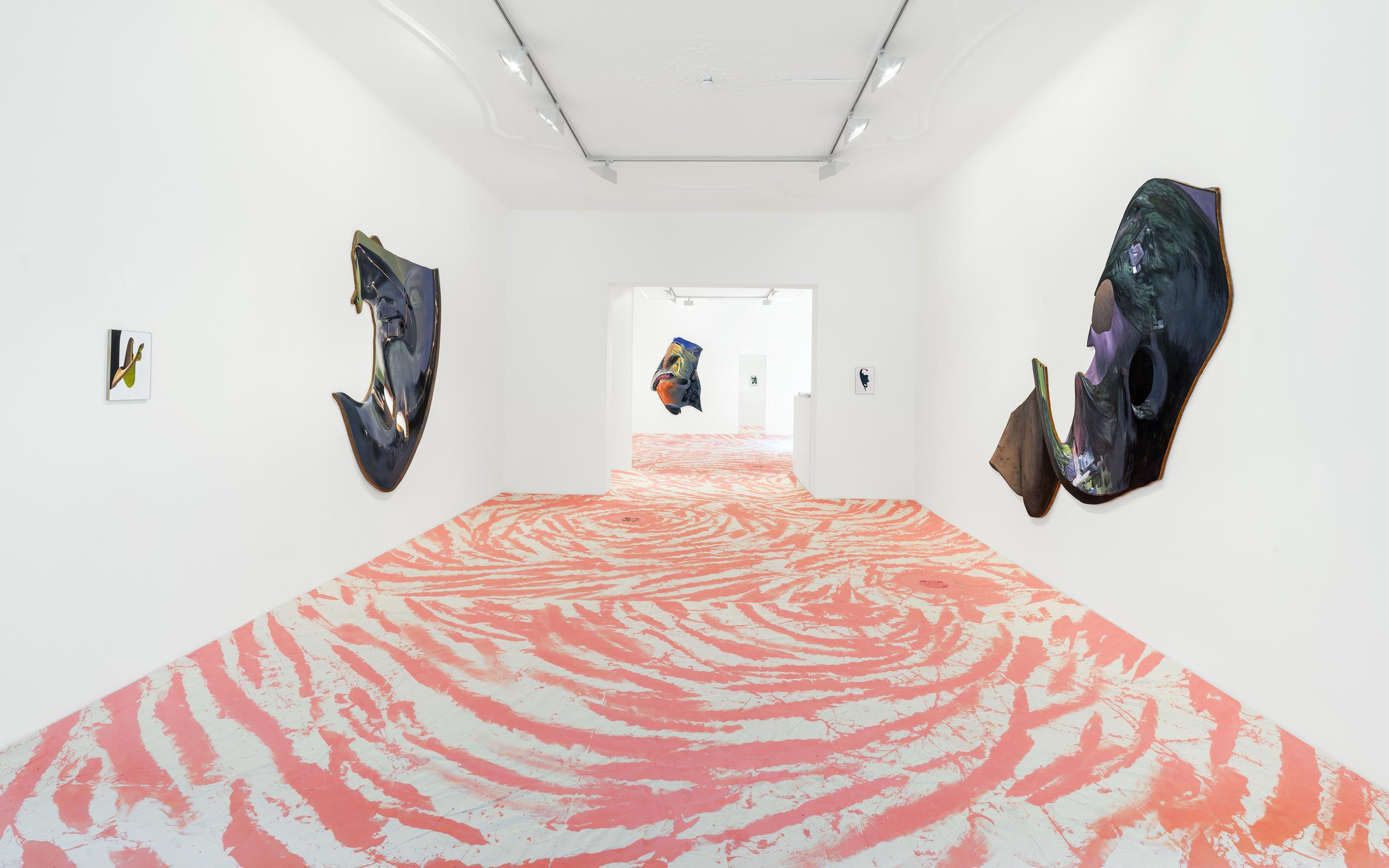
Stefan Reiterer, Deflection, 2022, exhibition view at Galerie CRONE, Berlin; © Uwe Walter
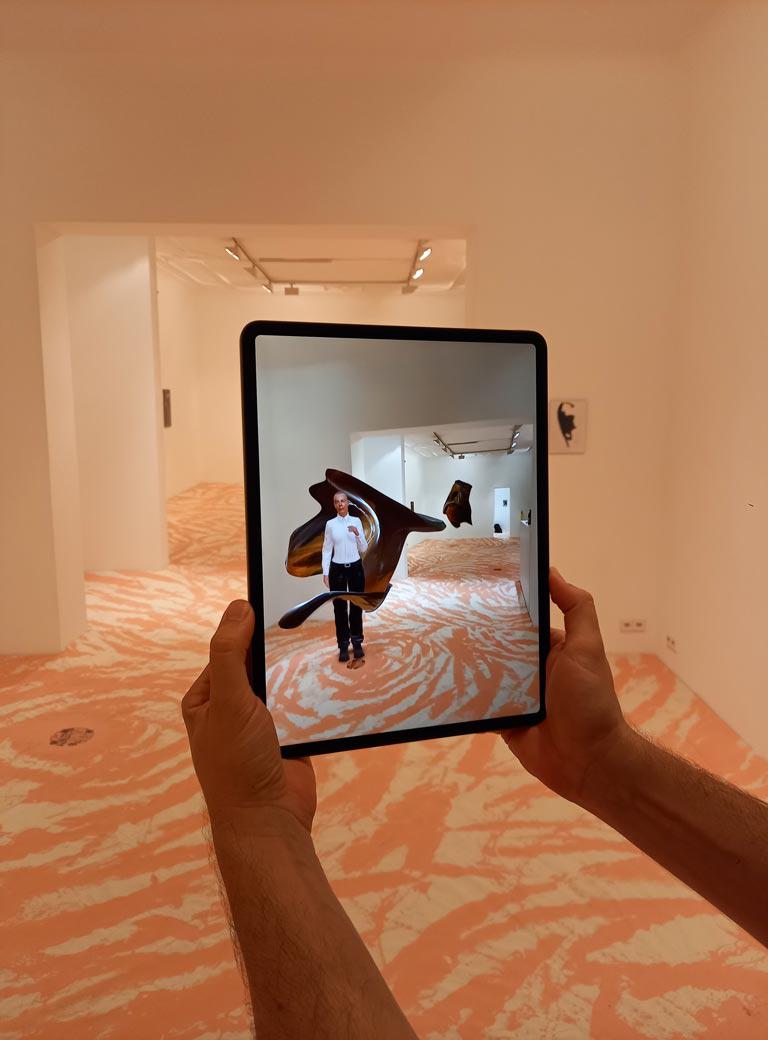
Stefan Reiterer & Jeremy Bailey, AR-Intervention, Deflection, 2022, Exhibition view, Galerie CRONE, Berlin; © Stefan Reiterer

Stefan Reiterer, Displacement, 2020, Exhibition view, Galerie CRONE, Wien; © Peter Mochi
Interview: Marieluise Röttger
Photos: Christoph Liebentritt


